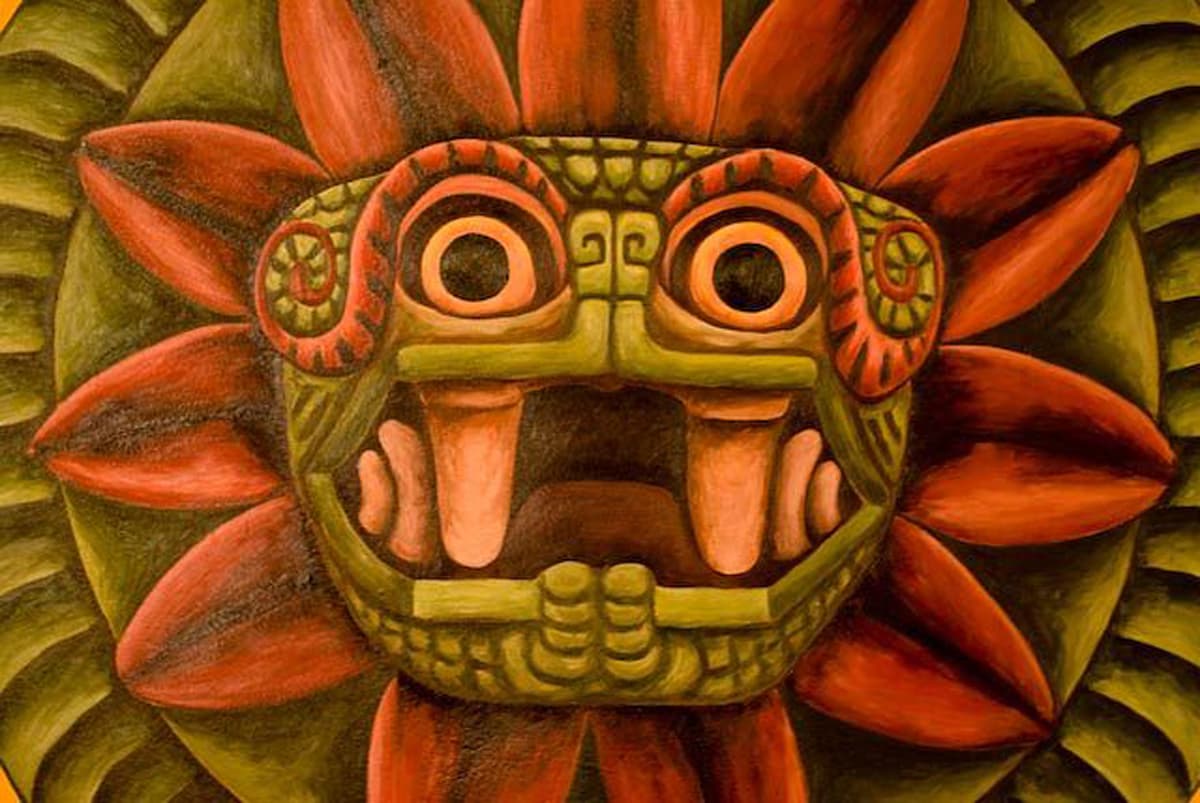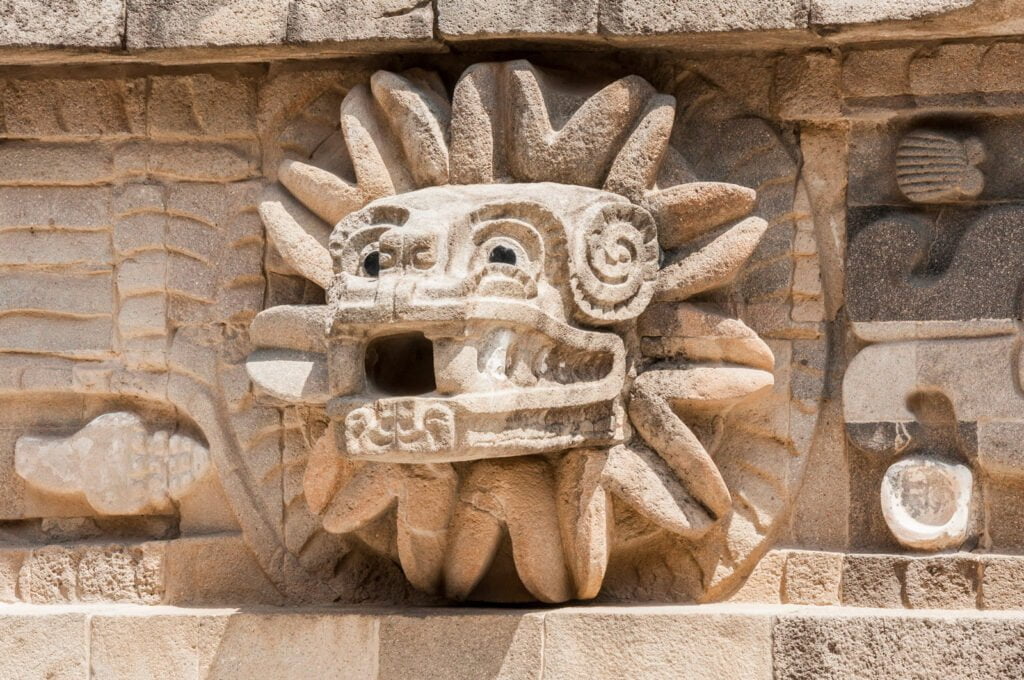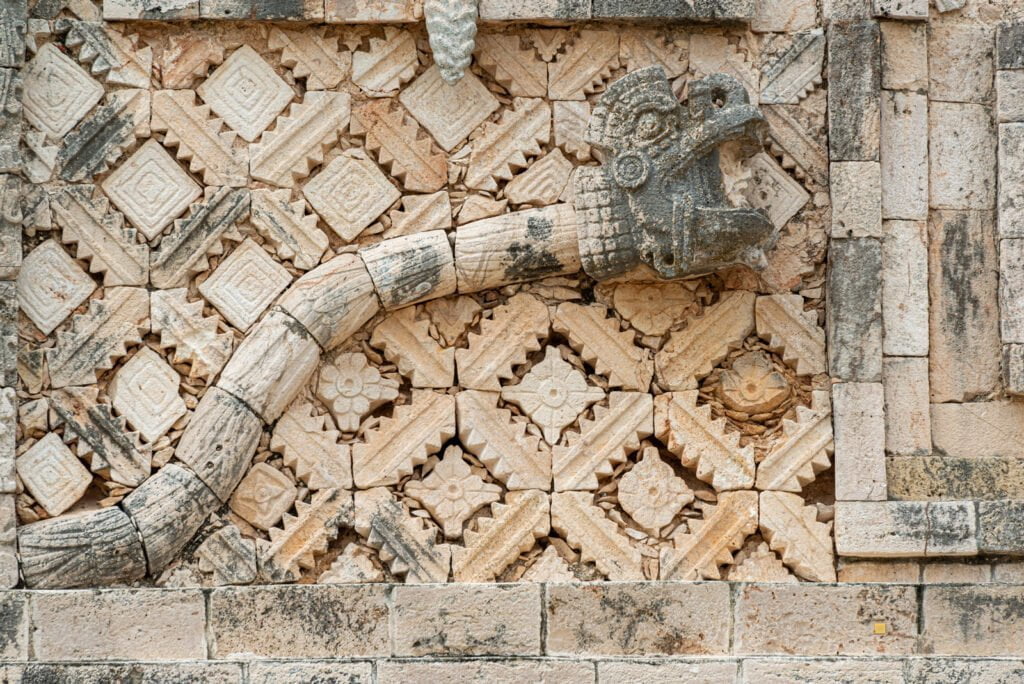Quetzalcoatl and its legend

Featured products Learn more about our offer
View allThe world of mythology of the indigenous peoples of South America contains many fascinating stories about the reality around us. Quetzalcoatl also known as Kukulkan or Feathered Serpent may care for one of them.
People have always explained phenomena incomprehensible to them. The existence of supernatural forces guiding the fate of the world. It is worth noting how found reality affects the shape and image of gods in various cultures. The gods of the northern peoples were more selfish, spiteful and wilful. Southern peoples, on the other hand. They live in an environment rich in fertile land and abundant natural resources. They believed in helpful and life-supporting deities. The Indigenous Gods are no different.


Feathered stone serpent at the Temple of Quetzalcoatl in Teotihuacan, Mexico
South America is a lush and diverse environment. Its reflection can be seen in the culture and beliefs of native inhabitants. Indigenous mythology is rich in various deities and mystical creatures. The world itself, as legends say, was created by many gods.
One of the creators of the world was a Mesoamerican deity, whose name comes from the Nahuatl language and means “feathered serpent”. Depending on the region, he had different names and epithets. In Aztec culture, he was known as Quetzalcoatl, Gucumatz, Votan, Ehecatl, as the god of wind or Tlahuizcalpantecuhtli, as the representative of the morning star. In Mayan culture, he was known as Kukulcan. Quetzalcoatl sat in the pantheon of Aztec gods, alongside Tlaloc, Tezcatlipoca, and Huitzilopochtli. He was considered the god of wind, sky, earth, water, fertility, dawn, merchants, art, craftsmanship, and knowledge. He was also the patron saint of the Aztec priesthood. The significance of this god is evidenced, among other things, by the pyramid located in the ancient city of Teotihuacan in Mexico. It is the third-largest structure and one of the oldest in Mesoamerica.[1] Quetzalcoatl – Codex Telleriano-Remensis
It is not known exactly when and which people created the cult of the Feathered Serpent. This stemmed from the culture of the time, which, in creating their own states based on previous ones, blurred their memory and presented their achievements as their own. She obliterated their memory and presented their achievements as her own. It is known, however, that the Olmec civilization was the first civilization of Mesoamerica, dating back to around 1500 BCE. They worshipped the image of the feathered serpent, which was a deity of the earth, agriculture, fertility, and fire. The Olmec serpent was probably the precursor to the Aztec god Quetzalcoatl.
The myth of the creation of the world
According to beliefs, it was in Teotihuacán, Mexico. After the expiration of the fourth sun, which heralded the end of the world. The gods met to debate which of them should become the fifth sun. Thus extending the life of the world. Tecuciztecatl, a haughty and proud god, declared himself sacrificed. However, the other gods favoured Nanahuatzin, the smallest and humblest among them. The gods lit a great fire. At the last second, Tecuciztecatl refused to jump into the fire, overcome by fear of pain. Nanahuatzin jumped in instead. Embarrassed by Nanahuatzin’s sacrifice, Tecuciztecatl followed suit. Two suns rose in the sky, but together they were too bright. The gods threw a rabbit at Tecuciztecatl to dim its light. This is how the moon was created.[2] One legend says that Quetzalcoatl went to the underground world of Mictlan and created the current world of the fifth sun from the bones of previous races using his blood.


The impact of colonization on mythology
Quetzalcoatl appeared taking the form of a white bearded man. According to oral legends, Quetzalcoatl gifted humans with a calendar marking the days of the fifth sun. He created astronomy and mathematics. He taught people to grow maize and cotton. It’s worth noting some similarities in the creation story to the Christian religion. In addition to the image of a white, bearded man resembling Jesus, Quetzalcoatl was also said to have been born of a virgin. However, in this case, she was a goddess. In the year 999, Quetzalcoatl left the indigenous people, leaving them with prophecies. The feathered serpent prophesied the arrival of white conquerors from across the ocean, who would overthrow the indigenous gods and replace them with their own, undefined deity. He also foretold his return in the year of reed, occurring every 52 years. A little over 500 years later, in 1519 during the year of reed. In the place where Quetzalcoatl predicted his re-emergence. A ship appeared. Spanish conquistadors led by Hernán Cortés arrived in the Americas [3]. The prediction came true in a perverse way. Since the 16th century, it was believed that the Aztec emperor Montezuma II initially mistook the landing of Hernán Cortés for the return of Quetzalcoatl. However, this view has been challenged by historians who claim that no document independent of Spanish influences has been found linking Quetzalcoatl to Cortés[4]. Nonetheless, this prophecy may have been a reason for excessive trust towards the invaders and their easy penetration inland.


Kukulkan in Uxmal, Mexico
Good god, bad followers
The precise meaning and characteristics of Quetzalcoatl vary somewhat depending on the civilization and throughout history. There are several stories about the birth of Quetzalcoatl. In one myth, Quetzalcoatl was born from a virgin named Chimalman, who was visited in a dream by the god Onteol. Another story tells that Chimalman was struck in the womb by an arrow shot by Mixcoatla, the Aztec god of the stars. Nine months later, she gave birth to a child whom she named Quetzalcoatl. The third story tells of Quetzalcoatl’s birth by the goddess Coatlicue, the mother of four hundred children who formed the stars of the Milky Way. According to another version of the myth, Quetzalcoatl is one of the four sons of Ometecuhtli and Omecihuatl, the four Tezcatlipocas, each of whom presides over one of the four main directions.[5]. Quetzalcoatl was often considered the god of the morning star, while his twin brother Xolotl was regarded as the evening star (Venus). As the morning star, he was known by the title Tlahuizcalpantecuhtli, meaning “lord of the star of dawn”. Quetzalcoatl was also the patron of priests and bore the title of the twin high priests of the Aztecs. The feathered serpent created a world full of peace and harmony, earning him respect and admiration. Some legends describe him as opposed to the practice of human sacrifice. Over time, his intentions were distorted, and despite his clear opposition to his teachings, human sacrifices were also made on his altars. Quetzalcoatl ruled during one of the five eras of creation, during which he and his spouse brought to life the last known human race. They then taught them how to obtain food, light fires, and make offerings to the gods.
Precious gifts for humanity
One of the valuable gifts received from the wind god was maize, the sacred food that formed the basis of the diet of the Mesoamerican peoples. Interestingly, maize in the form of flour was used as an ingredient in beverages, mixed with cacao, which is also a gift from the feathered serpent, chilli peppers, and other spices. It formed the basis of a staple beverage used daily by the indigenous peoples. Quetzalcoatl was considered the founder and patron of numerous ruling dynasties throughout Mesoamerica[3]. He also assumed human form as Topiltzin Quetzalcoatl, who ruled Tollan, the kingdom of the Toltecs idealized in Aztec mythology. Quetzalcoatl did not perish with the conquest of the continent. He lives on in contemporary indigenous thought and played a role in shaping modern Mexican culture. He also wandered into modern cults. Some Mormons believe that Quetzalcoatl was, in fact, Jesus Christ. According to the Book of Mormon, Jesus visited the American continent after his resurrection. Scholar Brant Gardner of the “Latter-day Saints” noticed that during the Spanish conquest, Native Americans and sympathetic Catholic priests felt pressure to link Native American beliefs with Christianity, making Native Americans appear more human and less wild.[6]. Various theories about Quetzalcoatl circulate among followers of the New Age movement, especially since the publication of Tony Shearer’s book “Lord of the Dawn: Quetzalcoatl and the Tree of Life” in 1971.
Did the Feathered Serpent really create the world? Has our knowledge of his worship warped over the centuries? Some questions will never be answered. Others will find answers with the help of science and the hard work of researchers and anthropologists.
